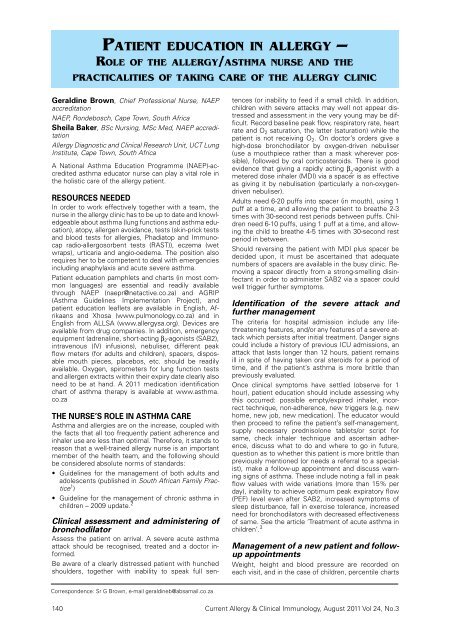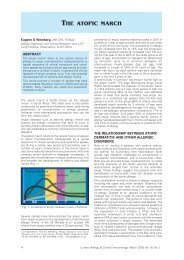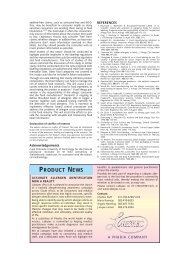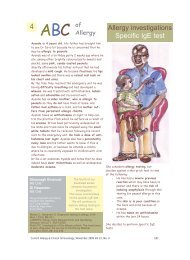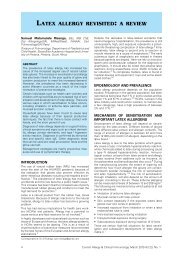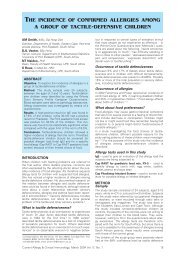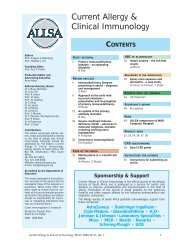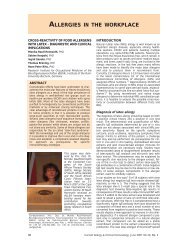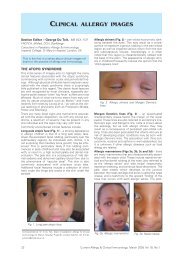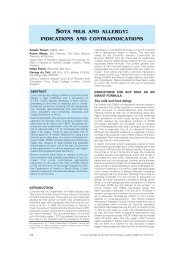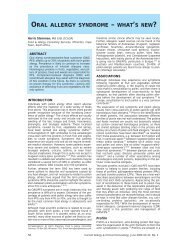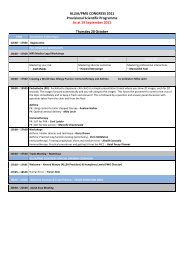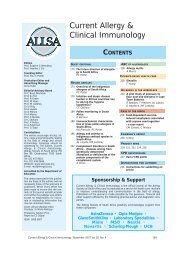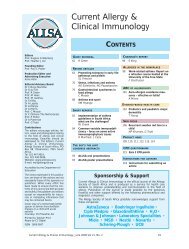Create successful ePaper yourself
Turn your PDF publications into a flip-book with our unique Google optimized e-Paper software.
Pa t i e n t e d u c a t i o n in a l l e rg y –<br />
Ro l e o f t h e a l l e rg y/a s t h m a n u r s e a n d t h e<br />
practicalities o f t a k i n g c a r e o f t h e a l l e rg y clinic<br />
Geraldine Brown, Chief Professional Nurse, NAEP<br />
accreditation<br />
NAEP, Rondebosch, Cape Town, South Africa<br />
Sheila Baker, BSc Nursing, MSc Med, NAEP accreditation<br />
Allergy Diagnostic and Clinical Research Unit, UCT Lung<br />
Institute, Cape Town, South Africa<br />
A National Asthma Education Programme (NAEP)-accredited<br />
asthma educa<strong>to</strong>r nurse can play a vital role in<br />
the holistic care of the allergy patient.<br />
RESOURCES NEEDED<br />
In order <strong>to</strong> work effectively <strong>to</strong>gether with a team, the<br />
nurse in the allergy clinic has <strong>to</strong> be up <strong>to</strong> date and knowledgeable<br />
about asthma (lung functions and asthma education),<br />
a<strong>to</strong>py, allergen avoidance, tests (skin-prick tests<br />
and blood tests for allergies, Phadia<strong>to</strong>p and Immunocap<br />
radio-allergosorbent tests (RAST)), eczema (wet<br />
wraps), urticaria and angio-oedema. The position also<br />
requires her <strong>to</strong> be competent <strong>to</strong> deal with emergencies<br />
including anaphylaxis and acute severe asthma.<br />
Patient education pamphlets and charts (in most common<br />
languages) are essential and readily available<br />
through NAEP (naepr@netactive.co.za) and AGRIP<br />
(Asthma Guidelines Implementation Project), and<br />
patient education leaflets are available in English, Afrikaans<br />
and Xhosa (www.pulmonology.co.za) and in<br />
English from <strong>ALLSA</strong> (www.allergysa.org). Devices are<br />
available from drug companies. In addition, emergency<br />
equipment (adrenaline, short-acting β 2 -agonists (SAB2),<br />
intravenous (IV) infusions), nebuliser, different peak<br />
flow meters (for adults and children), spacers, disposable<br />
mouth pieces, placebos, etc. should be readily<br />
available. Oxygen, spirometers for lung function tests<br />
and allergen extracts within their expiry date clearly also<br />
need <strong>to</strong> be at hand. A 2011 medication identification<br />
chart of asthma therapy is available at www.asthma.<br />
co.za<br />
THE NURSE’S ROLE IN ASTHMA CARE<br />
Asthma and allergies are on the increase, coupled with<br />
the facts that all <strong>to</strong>o frequently patient adherence and<br />
inhaler use are less than optimal. Therefore, it stands <strong>to</strong><br />
reason that a well-trained allergy nurse is an important<br />
member of the health team, and the following should<br />
be considered absolute norms of standards:<br />
• Guidelines for the management of both adults and<br />
adolescents (published in South African Family Practice<br />
1 )<br />
• Guideline for the management of chronic asthma in<br />
children – 2009 update. 2<br />
Clinical assessment and administering of<br />
bronchodila<strong>to</strong>r<br />
Assess the patient on arrival. A severe acute asthma<br />
attack should be recognised, treated and a doc<strong>to</strong>r informed.<br />
Be aware of a clearly distressed patient with hunched<br />
shoulders, <strong>to</strong>gether with inability <strong>to</strong> speak full sentences<br />
(or inability <strong>to</strong> feed if a small child). In addition,<br />
children with severe attacks may well not appear distressed<br />
and assessment in the very young may be difficult.<br />
Record baseline peak flow, respira<strong>to</strong>ry rate, heart<br />
rate and O 2 saturation, the latter (saturation) while the<br />
patient is not receiving O 2 . On doc<strong>to</strong>r’s orders give a<br />
high-dose bronchodila<strong>to</strong>r by oxygen-driven nebuliser<br />
(use a mouthpiece rather than a mask wherever possible),<br />
followed by oral corticosteroids. There is good<br />
evidence that giving a rapidly acting β 2<br />
-agonist with a<br />
metered dose inhaler (MDI) via a spacer is as effective<br />
as giving it by nebulisation (particularly a non-oxygendriven<br />
nebuliser).<br />
Adults need 6-20 puffs in<strong>to</strong> spacer (in mouth), using 1<br />
puff at a time, and allowing the patient <strong>to</strong> breathe 2-3<br />
times with 30-second rest periods between puffs. Children<br />
need 6-10 puffs, using 1 puff at a time, and allowing<br />
the child <strong>to</strong> breathe 4-5 times with 30-second rest<br />
period in between.<br />
Should reversing the patient with MDI plus spacer be<br />
decided upon, it must be ascertained that adequate<br />
numbers of spacers are available in the busy clinic. Removing<br />
a spacer directly from a strong-smelling disinfectant<br />
in order <strong>to</strong> administer SAB2 via a spacer could<br />
well trigger further symp<strong>to</strong>ms.<br />
Identification of the severe attack and<br />
further management<br />
The criteria for hospital admission include any lifethreatening<br />
features, and/or any features of a severe attack<br />
which persists after initial treatment. Danger signs<br />
could include a his<strong>to</strong>ry of previous ICU admissions, an<br />
attack that lasts longer than 12 hours, patient remains<br />
ill in spite of having taken oral steroids for a period of<br />
time, and if the patient’s asthma is more brittle than<br />
previously evaluated.<br />
Once clinical symp<strong>to</strong>ms have settled (observe for 1<br />
hour), patient education should include assessing why<br />
this occurred: possible empty/expired inhaler, incorrect<br />
technique, non-adherence, new triggers (e.g. new<br />
home, new job, new medication). The educa<strong>to</strong>r would<br />
then proceed <strong>to</strong> refine the patient’s self-management,<br />
supply necessary prednisolone tablets/or script for<br />
same, check inhaler technique and ascertain adherence,<br />
discuss what <strong>to</strong> do and where <strong>to</strong> go in future,<br />
question as <strong>to</strong> whether this patient is more brittle than<br />
previously mentioned (or needs a referral <strong>to</strong> a specialist),<br />
make a follow-up appointment and discuss warning<br />
signs of asthma. These include noting a fall in peak<br />
flow values with wide variations (more than 15% per<br />
day), inability <strong>to</strong> achieve optimum peak expira<strong>to</strong>ry flow<br />
(PEF) level even after SAB2, increased symp<strong>to</strong>ms of<br />
sleep disturbance, fall in exercise <strong>to</strong>lerance, increased<br />
need for bronchodila<strong>to</strong>rs with decreased effectiveness<br />
of same. See the article ‘Treatment of acute asthma in<br />
children’. 3<br />
Management of a new patient and followup<br />
appointments<br />
Weight, height and blood pressure are recorded on<br />
each visit, and in the case of children, percentile charts<br />
Correspondence: Sr G Brown, e-mail geraldineb@absamail.co.za<br />
140 Current Allergy & Clinical Immunology, August 2011 Vol 24, No.3
should be used in order <strong>to</strong> plot growth. Ascertain frequency<br />
of symp<strong>to</strong>ms: recurrent cough, particularly at<br />
night, wheeze, shortness of breath and tight chest. Be<br />
aware of symp<strong>to</strong>ms that are worse or prolonged in the<br />
presence of triggers, and patient his<strong>to</strong>ry (or family his<strong>to</strong>ry)<br />
of eczema, rhinitis, allergies, etc. Exacerbations<br />
– note frequency and duration. Finally, observe for obvious<br />
signs of allergy, eczema, allergic salute.<br />
Conducting lung function tests (LFTs) in<br />
the clinic<br />
Peak expira<strong>to</strong>ry flow. Compare PEF with best personal<br />
or charts of predicted value for age/height (adults) or<br />
height (children) and record. Patient should stand. Take<br />
3 readings, and record the highest of these. Always<br />
demonstrate carefully <strong>to</strong> new patients. The educa<strong>to</strong>r<br />
should be aware of the following: use the same type<br />
of peak flow; under 4 years the readings may not be<br />
accurate. Fac<strong>to</strong>rs which affect PEF include chronic obstructive<br />
pulmonary disease (COPD), technique, time of<br />
day, recent use of bronchodila<strong>to</strong>r, and false teeth. If PEF<br />
is less than expected, give an adequate dose of SAB2,<br />
wait 10 minutes and then redo the LFTs. Work out peak<br />
flow variability. Subtract the lowest reading from the<br />
highest reading, divide by the highest reading, multiply<br />
by 100% and this will then give you the percentage variability.<br />
More than 15% diurnal or variation on bronchodila<strong>to</strong>r<br />
reversibility testing, exercise testing or steroid trial<br />
testing may indicate or confirm asthma.<br />
Flow volume loop, forced expira<strong>to</strong>ry volume after 1<br />
second (FEV 1 ) and forced vital capacity (FVC). These<br />
lung volumes and capacities are measured with spirometers.<br />
Correct blowing technique and evaluation of normal<br />
and abnormal should be carried out. The educa<strong>to</strong>r<br />
should be knowledable regarding normal and abnormal<br />
curves (possibly due <strong>to</strong> insufficient cooperation as opposed<br />
<strong>to</strong> irritable airways). Most modern LF equipment<br />
will show pre- and post-bronchodilation, with percentages,<br />
readily and easily. Print and attach for doc<strong>to</strong>r in<br />
the folder.<br />
It is a good idea <strong>to</strong> encourage patients <strong>to</strong> bring their devices<br />
(including spacers) <strong>to</strong> the clinic visit every time.<br />
After the doc<strong>to</strong>r has seen the patient and taken a full<br />
detailed his<strong>to</strong>ry (current and past medical, asthma,<br />
smoking his<strong>to</strong>ry, occupation, previous and current asthma<br />
medication, over-the-counter meds, etc), the nurse<br />
might be asked <strong>to</strong> conduct or explain one of the following<br />
tests <strong>to</strong> the patient, in order <strong>to</strong> confirm his/her<br />
suspicions of asthma, in spite of normal LFTs.<br />
Use of diary cards<br />
Keeping and recording peak flow at home for 2 weeks.<br />
Give a patient a peak flow meter and peak flow diary<br />
chart, so that they can record their peak flow. Advise<br />
patient <strong>to</strong> carry out PEF at the same time of day, every<br />
morning and every night, prior <strong>to</strong> medication, and<br />
<strong>to</strong> record treatment (inhaled corticosteroid, SAB2 and<br />
long-acting β 2 -agonists), and <strong>to</strong> administer SAB2 when<br />
necessary. Patient should record pre and post values.<br />
When patients return for a follow-up appointment, the<br />
educa<strong>to</strong>r will calculate the PEF variability and be aware<br />
that a greater than 15% diurnal variation indicates<br />
asthma (very often an early morning dip), and that a<br />
stable PEF recording within normal range indicates that<br />
asthma (if present) is well controlled. Patients should<br />
be encouraged never <strong>to</strong> s<strong>to</strong>p medication until they have<br />
seen the doc<strong>to</strong>r.<br />
Conducting an exercise test<br />
Measure peak flow (highest of 3 readings). Patient then<br />
takes vigorous continuous exercise for 6 minutes, repeat<br />
the PEF immediately, and repeat at 5-minute intervals<br />
for 15 minutes. A fall of 15% or more is positive.<br />
Administer SAB2 if necessary. Always bear in mind that<br />
the greater the variability, the more hyperresponsive<br />
the airways.<br />
Skin-prick tests<br />
Having taken a good his<strong>to</strong>ry, the doc<strong>to</strong>r will identify<br />
which allergens he/she wishes <strong>to</strong> be tested. The patient<br />
must not have taken any antihistamines for the<br />
previous 72 hours. If excema is widespead on the arms,<br />
the back may be used. A full and comprehensive explanation<br />
can be found in the <strong>ALLSA</strong> Handbook. 4 Patients<br />
need <strong>to</strong> give consent (sign and date the form), and the<br />
person performing the skin-prick test must sign as well.<br />
Be aware of derma<strong>to</strong>graphism and pseudopodia and record<br />
them in the notes. Blood tests may be ordered.<br />
Education and treating specific allergies<br />
Identify the allergens and proceed with allergen avoidance<br />
information. Provide patient with information<br />
sheets. Should any his<strong>to</strong>ry prove that a trigger is potentially<br />
life-threatening, discuss the need for a Medic Alert<br />
bracelet. A clearly marked action form should state what<br />
<strong>to</strong> do and when. In a mild reaction antihistamines may<br />
suffice, but if there are any respira<strong>to</strong>ry symp<strong>to</strong>ms, then<br />
4 puffs of SAB2 should be administered. Should the reaction<br />
be major with breathing difficulties or change in<br />
consciousness, then adrenaline should be given intramuscularly.<br />
A small pack should be given <strong>to</strong> take home,<br />
with either a vial of adrenaline (check expiry date), or<br />
Epipen, with instructions on how <strong>to</strong> give the adrenaline.<br />
The usual dose for an adult is 0.5 ml intramuscularly and<br />
for a child over 3 years 0.3 ml intramuscularly immediately.<br />
The injection must be repeated if no response<br />
in 5 minutes and the patient must be brought <strong>to</strong> the<br />
emergency room.<br />
Most common inhalant allergens tested are: house-dust<br />
mite (HDM), grass, moulds, dog, cat, tree – seasonal<br />
changes will determine further requests. Skin-prick<br />
tests are also available for a range of food allergens and<br />
their negative predicted value is very good.<br />
Practical tips on how <strong>to</strong> avoid HDMs (the most common<br />
allergen). While this can be time-consuming, it is<br />
of vital importance, because <strong>to</strong>gether with appropriate<br />
pharmacotherapy, you can improve the control of a patient<br />
with asthma. Mattress, duvet and pillow cases<br />
should be encased in high-quality, mite-impermeable<br />
covers. Hot water (>60°C) is effective in killing HDM.<br />
Rooms should not be vacuumed while the patient is in<br />
the room, and soft <strong>to</strong>ys should be placed in the freezer<br />
overnight once a month.<br />
Treating concomitant rhinitis. Unless the often concomitant<br />
allergic rhinitis is treated, asthma can remain<br />
uncontrolled in spite of optimal treatment. Rhinitis education<br />
should include: using the nasal spray as often<br />
as prescribed by the doc<strong>to</strong>r. There may well not be an<br />
apparent immediate effect, but continuous use is essential.<br />
Blow the nose gently (most rhinitis sufferers<br />
will be more prone <strong>to</strong> nose bleeds than the general<br />
population). These patients will also have more mucus<br />
and sneezing than others. Shake the medicine, and<br />
then insert in<strong>to</strong> the nose, turning the end of the canister<br />
on the right side in the direction <strong>to</strong>wards the right ear<br />
and left <strong>to</strong>wards the left ear. Try not <strong>to</strong> blow the nose<br />
for some time thereafter. Depending on the severity of<br />
the symp<strong>to</strong>ms, drug therapy will involve antihistamine<br />
tablets and/or nasal corticosteroids. In cases of severe<br />
seasonal allergic rhinitis <strong>to</strong> grass and other mono-allergens,<br />
allergen injection or sublingual administration of<br />
immunotherapy may be used. This can be effective and<br />
needs adherence for 3 years, so the doc<strong>to</strong>r needs <strong>to</strong><br />
identify appropriate patients.<br />
Current Allergy & Clinical Immunology, August 2011 Vol 24, No.3 141
A<strong>to</strong>pic dermatitis or eczema. All allergy nurses should<br />
be able <strong>to</strong> teach and demonstrate wet wrapping, especially<br />
for infants. This involves applying s<strong>to</strong>ckinette bandages<br />
<strong>to</strong> the body and limbs. After bathing the child, apply<br />
emulsifying ointment in place of soap. Pat the child<br />
dry with a clean <strong>to</strong>wel and immediately apply a layer of<br />
ointment (and <strong>to</strong>pical steroid cream if so ordered). Place<br />
one bandage in warm tap water and apply <strong>to</strong> the area,<br />
followed by a second dry bandage. Encourage patients/<br />
parents <strong>to</strong> keep this on while the patient is sleeping. No<br />
occlusive bandaging should be applied <strong>to</strong> an infected<br />
skin.<br />
Education should also include avoidance of irritants,<br />
e.g. heat, wool and soap. Avoid allergens (HDM, animal,<br />
food). Apply emollients as frequently as possible,<br />
with intermittent or when necessary <strong>to</strong>pical steroid (as<br />
per prescription) application, when the eczema is active.<br />
Encourage the patient <strong>to</strong> s<strong>to</strong>p after 7 continuous<br />
days of use, <strong>to</strong> take a break for a few days, then if not<br />
improved, <strong>to</strong> recommence. The aim is <strong>to</strong> use the weakest<br />
steroid for the shortest time needed, in order <strong>to</strong><br />
control active disease. Do not apply 10% steroid <strong>to</strong> the<br />
face. Keep the patient’s fingernails short and recognise<br />
and treat infections. Patients often undertreat with <strong>to</strong>pical<br />
steroids.<br />
Parents should also be <strong>to</strong>ld that eczema is not contagious<br />
or infectious. The school teacher could be informed.<br />
However, as eczema skin often dries, cracks<br />
and breaks, it puts the sufferer at a greater risk of contracting<br />
skin infections. Treat these immediately. The<br />
usual childhood immunisations generally pose no problem.<br />
Advice includes: moisturise 4-hourly, apply ice (in<br />
a wrapping, it cools and can help ease itching), wear<br />
100% cot<strong>to</strong>n clothing, remove labels from clothes, and<br />
place cot<strong>to</strong>n sheets on the patient’s chair <strong>to</strong> avoid itching<br />
and burning at the back of the legs.<br />
OTHER CIRCUMSTANCES<br />
The allergy nurse should also be familiar and knowledgeable<br />
about asthma in special circumstances, e.g.<br />
in the elderly who may sometimes need higher than<br />
normal doses in order <strong>to</strong> successfully reverse the bronchospasm.<br />
Ipratropium bromide bronchodila<strong>to</strong>r reversibility<br />
testing can be carried out in the same way, with<br />
PEF before and 30-45 minutes after administration.<br />
Pregnancy: Asthma is one of the most common chronic<br />
illnesses that can complicate pregnancy. It may occur<br />
for the first time or it may be altered by it. About onethird<br />
of women are worse, one-third remain the same<br />
and one-third improve.<br />
Occupational asthma (OA): suspecting a diagnosis of<br />
OA is relatively easy; confirming and dealing with the<br />
long-term effects and possible changing of jobs is much<br />
more complex and should be referred <strong>to</strong> a specialist.<br />
Certain drugs may make asthma worse. These include<br />
beta-blockers, non-steroidal anti-inflamma<strong>to</strong>ry drugs<br />
(e.g. voltaren, aspirin), anxiety medications and antiepileptic<br />
drugs.<br />
GENERAL EDUCATION<br />
Having seen the doc<strong>to</strong>r, the patients’ medication will be<br />
decided upon, based on a number of important fac<strong>to</strong>rs.<br />
Table I. Asthma devices<br />
Discuss with the patient the specific device chosen by the doc<strong>to</strong>r as well as dosage and correct use. Do not breathe in<strong>to</strong> any<br />
device.<br />
Device Technique Care Age Instructions<br />
MDI Requires co-ordination. Keep dry and cool. Children/certain Patient <strong>to</strong> keep reliever<br />
Practice in front of mirror. Do not immerse in adults <strong>to</strong> use with them at all times.<br />
Any questionable technique water. Shake before spacer for Rinse sleeve if blocked.<br />
should prompt the use of a use and replace cap enhanced Rinse mouth after ICS.<br />
spacer or dry powder device after use deposition Only actuate one dose<br />
(Fig. 1) at a time. Slow, deep<br />
inspiration is best<br />
Turbuhaler Twist anti- and clockwise Check dose counter, Not suitable Symbicord can be<br />
till the click is heard. No red marker indicates for the young used when necessary<br />
sound, taste or feel. last few doses child in acute asthma.<br />
Long slow suck necessary.<br />
No refill available.<br />
Rinse mouth after ICS<br />
DP Caps, used Long slow thirsty Clean mouthpiece. Not for the Rinse mouth after use.<br />
with either DP suck. Easy <strong>to</strong> identify Keep capsules in dry young or One blue capsule of<br />
inhaler or if dose has been taken. and cool conditions tight patients SAB2 contains 200 µg.<br />
Revolizer<br />
Novolizer Shows green strip which When empty Not for the Suck through the click<br />
changes <strong>to</strong> red when dose replace with very young (release of medication).<br />
has been taken. Has dose new refill. or elderly Rinse mouth after use.<br />
counter Clean device Check dosage<br />
PRN<br />
Accuhaler Easy <strong>to</strong> use, no refill Keep cool Not suitable Colour will indicate<br />
available. Long thirty and dry. for the very type of asthma<br />
suck. young. mediation –<br />
use as prescribed.<br />
Gentlehaler L-shaped sleeve which Rinse sleeve when Difficult <strong>to</strong> Speed at which the<br />
may be used with both necessary and depress and medication leaves the<br />
Asthavent and Budeflam keep medicine not easy <strong>to</strong> device is much less<br />
canister cool and use for the than normal MDI:<br />
dry very young enhanced deposition<br />
or elderly results<br />
MDI - metered dose inhaler, ICS – inhaled corticosteroids, SAB2 – short-acting β 2-agonist, PRN – as required<br />
142 Current Allergy & Clinical Immunology, August 2011 Vol 24, No.3
Table II. Spacers (Fig. 1)<br />
Spacers improve and enhance deposition in the airways. They overcome co-ordination and decrease local side-effects:<br />
thrush, hoarseness and cough. Spacers should not be shared among patients, and patients should be encouraged <strong>to</strong> bring<br />
them <strong>to</strong> each follow-up visit. All spacers should be primed when new and after washing; before using: wash in a mild detergent,<br />
air dry and actuate 4 or 5 doses of the most cost-effective asthma medication in<strong>to</strong> the device. Optimal delivery is<br />
assured, when 20 minutes later, it is used for administration of medication.<br />
Spacer Colour/compatibility 4 years Technique<br />
Glaxohaler Mostly purple, With mask Without mask Remove valve near<br />
(GSK) (10) sometimes orange. mouthpiece. Place mask<br />
Used with most MDIs.<br />
over mouth and nose, with<br />
Difficult <strong>to</strong> put back <strong>to</strong>gether, mouth open and allow 5<br />
if separated<br />
breaths per dose actuation.<br />
Shake in-between doses.<br />
Wash face after controllers<br />
Zerostat (Cipla) White, available with With face No face mask, Discourage hyperventilation,<br />
and mask and without valves mask – used directly particularly in older child.<br />
(11) Used with most MDIs. same ordered in mouth Shake in-between doses.<br />
Separates in<strong>to</strong> 2 halves, separately Wash face after using mask/<br />
easy <strong>to</strong> transport<br />
spacer for controllers.<br />
Neonate Orange. Used with
lasting up <strong>to</strong> 4 hours. If these are required frequently,<br />
the patient should seek medical help. During an acute<br />
attack, in lieu of a nebuliser, an SAB2, via MDI plus<br />
spacer may be used (20 puffs for adults and 10 puffs<br />
for children – one puff at a time). If there is no improvement<br />
refer <strong>to</strong> doc<strong>to</strong>r for possible oral steroids. Longacting<br />
β 2 -agonists (salmeterol or formoterol), should<br />
only be used in conjunction with inhaled corticosteroids<br />
(ICS), and never administered <strong>to</strong> preschoolers. Sideeffects<br />
include tremor, palpitations, headaches and<br />
facial flushing. In the case of under-2-year-olds and<br />
the elderly, ipratropium bromide (e.g. Ipvent) may be<br />
prescribed. Beneficial effects are noted 30-40 minutes<br />
after administration and side-effects include dry mouth<br />
and constipation.<br />
Explain the actions of controllers<br />
Identify specific device <strong>to</strong> be used and the dose required<br />
(budesonide, fluticasone propionate or beclomethasone).<br />
Explain that if taken regularly, every morning<br />
and every evening, the inflammation in the airways<br />
which causes asthma symp<strong>to</strong>ms will be reduced and<br />
this in turn should reduce the severity and frequency of<br />
acute attacks. Patients should not s<strong>to</strong>p until they next<br />
see their doc<strong>to</strong>r, even though symp<strong>to</strong>ms are not present.<br />
Side-effects are rare but may include hoarseness<br />
or oral thrush. This may be overcome by using a spacer<br />
or regular rinsing of the mouth, after each ICS administration.<br />
Reassure patients that corticosteroids used for<br />
asthma are different from anabolic steroids used by athletes.<br />
The appropriate device should be demonstrated<br />
and checked. Always have a placebo available and<br />
demonstrate the device yourself, then ask patient <strong>to</strong> do<br />
so. Watch closely and discuss any concerns. Correct<br />
technique with inhaler is essential and adherence vital.<br />
Tables I and II and Figure 1 illustrate and outline device<br />
techniques and care.<br />
An emergency action plan should be written down,<br />
taking in<strong>to</strong> account the patient’s lifestyle. Printed action<br />
plans are available at www.asthma.co.za<br />
Discuss a self-management plan. This should include<br />
the nature of asthma and how the patient can recognise<br />
signs and symp<strong>to</strong>ms of worsening asthma. These<br />
include deterioration in peak flow (if meter is used), increase<br />
in diurnal variations, an increase in symp<strong>to</strong>ms<br />
with more frequent use of bronchodila<strong>to</strong>rs, yet declining<br />
efficacy of same. Sleep disturbance and a decrease in<br />
exercise <strong>to</strong>lerance should also be recognised as signs of<br />
impending asthma deterioration. In addition, the patient<br />
should be <strong>to</strong>ld (and the plan written down) what action<br />
<strong>to</strong> take and where <strong>to</strong> go – even in the middle of the<br />
night, when <strong>to</strong> start prednisolone, how much, and how<br />
<strong>to</strong> avoid triggers (including smoking). Asthma symp<strong>to</strong>m<br />
and adherence diary available at www.asthma.co.za<br />
Finally, and most importantly, make a follow-up appointment.<br />
On all subsequent follow-up visits adherence<br />
(how many times did you forget your medication),<br />
inhaler technique evaluation, and an exploration<br />
of possible different health beliefs and/or psychological<br />
issues should be addressed in order <strong>to</strong> achieve optimal<br />
control.<br />
CONCLUSION<br />
A trained enthusiastic allergy and asthma nurse can<br />
work <strong>to</strong>gether with the health team and patients in order<br />
<strong>to</strong> strive for improved control and quality of life for<br />
all patients.<br />
THE FUTURE<br />
It would be a great advantage <strong>to</strong> have an allergy course<br />
where nurses can be trained as allergy nurse practitioners,<br />
who will work in conjunction with allergists and<br />
also function at primary health clinics where specialists<br />
are not always available. They could work in pathology<br />
services where they can conduct basic allergy tests,<br />
e.g. skin-prick tests. These allergy nurse practitioners<br />
would also provide patient education in areas beyond<br />
specialist clinics and assist doc<strong>to</strong>rs <strong>to</strong> refer patients <strong>to</strong><br />
the specialised centres when necessary.<br />
Acknowledgement<br />
We thank the authors of the National Asthma Education Programme<br />
Version 2011 which has been used for this article.<br />
We thank Prof Paul Potter for his invaluable assistance in the preparation<br />
of this article.<br />
Declaration of conflict of interest<br />
The authors declare no conflict of interest.<br />
References<br />
1. Lalloo U, Ainslie G, Wong M, et al. Guidelines for the management<br />
of asthma in adults and adolescents. South African Family Practice<br />
2007; 49 (5): 19-31.<br />
2. Motala C, Green RJ, Manjra AI, et al. Guideline for the management<br />
of chronic asthma in children - 2009 update. S Afr Med J 2009; 99:<br />
897-912.<br />
3. Kling S, Goussard P, Gie RP. Treatment of acute asthma in children.<br />
Current Allergy & Clinical Immunology 2011; 24: 22-26.<br />
4. Green RJ, Motala C, Potter PC, eds. <strong>ALLSA</strong> Handbook of Practical<br />
Allergy, 3rd ed. Cape Town: <strong>ALLSA</strong>, 2010: 17.<br />
Would you like <strong>to</strong> receive future copies of this journal<br />
Please contact our national office <strong>to</strong> be added <strong>to</strong> the mailing list.<br />
If you are interested in becoming a member of the Allergy Society of South Africa (<strong>ALLSA</strong>),<br />
please contact Mrs Ruwayda Adams for more details.<br />
<strong>ALLSA</strong> Office<br />
PO Box 88<br />
Observa<strong>to</strong>ry 7935<br />
Tel 021-447-9019<br />
Fax 021-448-0846<br />
Email mail@allergysa.org<br />
144 Current Allergy & Clinical Immunology, August 2011 Vol 24, No.3


